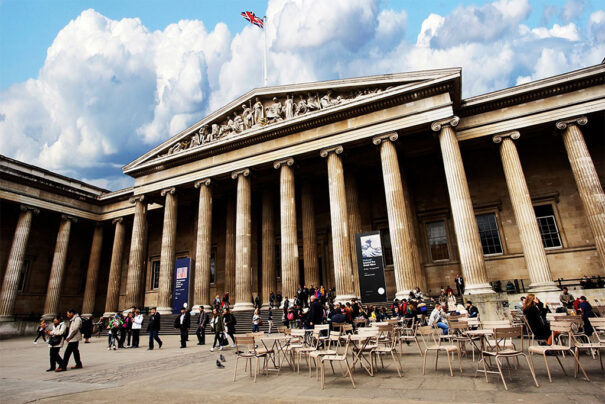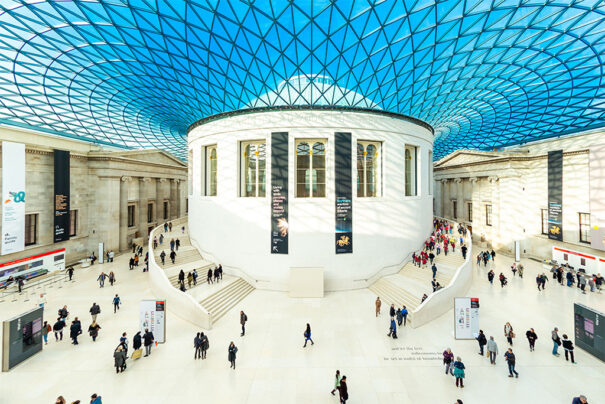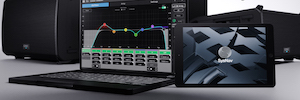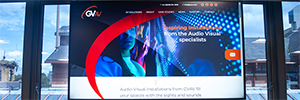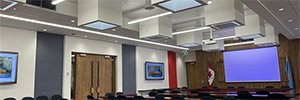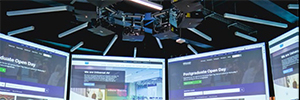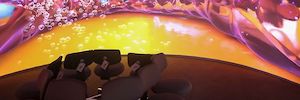El Museo Británico gestiona su equipamiento AV con QSC Q-SYS
El centro neurálgico de la galería Sainsbury, in the Museo Británico, es un procesador QSC Q-SYS Core 110f; mientras que la de Joseph Hotung se ha equipado con un sistema Q-SYS Core 8 Flex y el controlador de pantalla táctil Q-SYS TSC Series Gen 2, con pantalla de 8”.
Autograph Sound se ha encargado de actualizar el sistema que controla el contenido AV del Museo Británico y lo ha hecho tomando como base las soluciones de la línea QSC Q-SYS.
Hace más de doscientos cincuenta años, abrió sus puertas el primer museo público nacional del mundo, el Museo Británico. Desde entonces ha cuidado más de ocho millones de obras de arte, objetos históricos y hallazgos arqueológicos. Las exhibiciones se muestran en todo su potencial y se busca que la experiencia sea perfecta para los visitantes. Este objetivo es difícil de lograr con equipos y sistemas no estandarizados.
Para dar respuesta a este desafío, el equipo del Museo Británico seleccionó a la productora e integradora de sistemas Autograph Sound para actualizar el sistema que controla el contenido de audio y video de las exhibiciones. La propuesta se centró en la tecnología de QSC, en concreto en Q-SYS. Con esta solución ha construido una arquitectura de control modular y estandarizada que facilita un acceso fácil e inmediato.
“Nuestro ingeniero manejó toda la programación personalizada para el Museo y ahora los dos espacios, la galería de exposiciones Sainsbury y la de Joseph Hotung Great Court, tienen el audio, vídeo y control con Q-SYS. Ejecuta audio mientras administra proyectores, reproductores multimedia, reproducción de video y PC a través de interfaces de usuario portátiles dedicadas. In addition, el equipo audiovisual del museo se ha quedado con un diseño que pueden reconfigurar para adaptarlo a sus necesidades, en un lenguaje que es fácil de entender”, Explains Euan Mackenzie, responsable de desarrollo comercial de Autograph Sound.
El centro neurálgico de la galería de exposiciones Sainsbury Gallery es un procesador Q-SYS Core 110f, que se encarga de gestionar todas las E/S, enrutamiento y DSP de las aplicaciones de audio y vídeo.
Para adaptarse a una mayor variedad de formatos de audio, Autograph aprovechó la compatibilidad Dante, basada en el software de Q-SYS Core 110f, y agregó un convertidor PoE y una interfaz para llevar 16 entradas analógicas al estándar de red Dante Audio-over-IP. Esta expansión masiva permite que el equipo AV interno administre mejor la gran diversidad de diseños de exhibición entrantes.
For its part, la galería Joseph Hotung se ha equipado con un procesador Q-SYS Core 8 Flex y el controlador de pantalla táctil Q-SYS TSC Series Gen 2 con pantalla de ocho pulgadas, que permite un control gráfico simple y directo de todas las operaciones realizadas en este espacio.
El acceso de control no se limita al controlador de pantalla táctil Q-SYS. Para el personal del museo que interactúa con el público y realiza exhibiciones, el acceso debe ser fácil e inmediato.
“El departamento de atención al visitante es, en gran medida, el usuario final del sistema”, Says Clark Henry-Brown, responsable del equipo AV del Museo Británico. “La estructura abierta de Q-SYS nos ha permitido diseñar una interfaz de usuario de iPad separada para ellos, lo que les permite solucionar cualquier problema antes de escalar al equipo audiovisual. Si se está produciendo un evento o filmación en un espacio de exhibición, incluso pueden silenciar puntos de medios específicos, ahorrándonos nuevamente una llamada”.
El acceso de varios equipos también era imprescindible, como explica Henry-Brown. “Existe una experiencia multifacética para los usuarios de nuestro sistema Q-SYS para exhibiciones, que se explica mejor entre departamentos”.
Durante la fase de montaje de las exposiciones, Q-SYS se utiliza como un sistema de reproducción de audio y realiza todo el procesamiento de los altavoces. “Debido a que alojamos nuestro equipo de exhibición en salas de servidores, existe la necesidad de poder mezclarse de forma remota en el espacio de exhibición, lo que Q-SYS permite. In addition, podemos tener el control total del hardware de la exhibición y mezclar sobre la marcha mientras revisamos todo con el equipo de diseño. Nuestro sistema anterior no permitía esto”, añade Henry-Brown.
You liked this article?
Subscribe to our Feed And you won't miss a thing.
• Section: Audio, Case Studies, Control, Display, Signal distribution, Infrastructure



